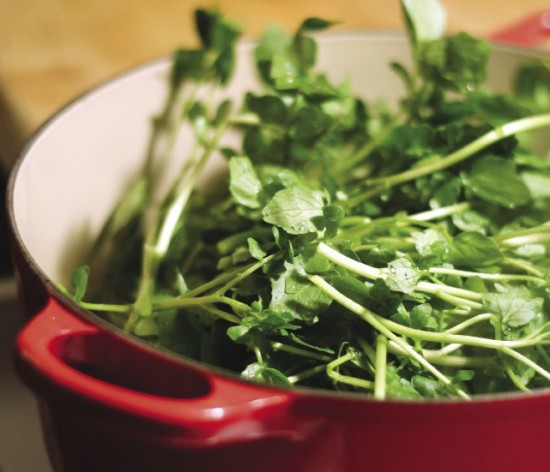
A narrow stream runs past my parents’ house in Cape Town, South Africa, on the eastern flank of Table Mountain. The water originates on the mountain, flowing heavily in the wet Cape winters, slowing to a trickle in summer.
My mother and I used to pick armfuls of watercress (Nasturtium officinale) from its shallows. In the kitchen sink she immersed the stems in a bath of potassium permanganate, the tiny dark shards dissolving into a spectacularly purple crime scene where the greens bobbed as the salts cleansed them of possible waterborne microbes.
I think it was overkill. The water on the mountain itself was—and remains—clean enough to be sipped from a cupped hand. But my mother has always been a careful woman.
A memorable early spring breakfast eaten in our garden with friends featured these intensely peppery leaves in an orange salad, creamy scrambled eggs laced with smoked salmon and shots of viscously cold vodka. I still associate watercress with a sparkle in the air, new leaves on the trees and a spring fizz in the blood. Earthy watercress soup accompanied the still-cool evenings, with slices of warm brown bread.
I left Cape Town for New York City, water-locked metropolis, land of islands and rivers and tides. Yet it is easy to forget about fresh water here. I was surprised when I stepped upon a familiar plant in Alley Pond Park, a swampy swathe of green on the edge of Queens. Pinnately compound leaves growing from a basal rosette: watercress.
I was deeply suspicious: Ten minutes earlier we had walked past a sign warning of sewage discharge, and all the leaves were in contact with the wet soil. Resisting the desire to sink my teeth into the greenery, I bit my lip and moved on.
I started to notice watercress all over the city. Despite its Eurasian origins, this semi-aquatic weed is ubiquitous. In Highbridge Park, a narrow insertion of tall trees and cliffs squeezed between the Harlem River Drive and Amsterdam Avenue, I found watercress growing at the foot of a rock face. Above it, water dripped from an iron pipe leading straight from the most heavily populated part of the United States. My husband propelled me away from temptation. “This is not the cress you are looking for.” He is a careful man. I have since seen watercress in Central Park, Pelham Bay Park, High Rock Park and Prospect Park. I do not pick it.
Polluted city water makes urban watercress potentially unsafe to eat. Naturally occurring clean water is an extinct resource in the megalopolis, and, despite what my mother thinks, I am a careful woman. Upstate cress is often no better; the presence of livestock can infest waterways with a nasty liver fluke. Cooking would kill its microscopic eggs (so would potassium permanganate, if you want to eat it raw). But the best watercress grows near a bona fide spring or pristine stream.
It took a springtime trip to the Rockefeller State Park Preserve in Westchester to deliver me at last to a patch of watercress beside a stream that ran sparkling and fresh. We collected the leaves and early white flowers for a salad whose lively bite is one of the healthiest things you can put in your mouth: peppery watercress is a superb and palatable source of sulforaphane, a phytochemical compound whose antioxidant function has been cited in recent studies as a potent weapon against cancer.
While watercress is verboten in my urban foraging life, I gather other cresses—fellow members of the mustard family whose feet need not remain wet. Upland cress (Barbarea verna) and winter cress (Barbarea vulgaris) are weeds that appear in city parks in early spring and are edible and delicious when harvested young. By the time the cress’s yellow flowers bloom on tall stems in late April, their leaves are bitter, but the flowers and buds are very good to eat. Upland cress seed is available commercially. I sow it on my terrace in spring and start collecting its young leaves two weeks later.
There is a wealth of ways to use all cresses:
Raw, with their cruciferous nutrition intact: a classic finger sandwich, the leaves tucked between thin slices of crustless, buttered bread. In bright-green gazpacho, with cucumber, green garlic and scallions. Piled onto orange slices, with slivers of chile for emphasis. Dressed with buttermilk vinaigrette, atop half-moons of avocado. Southeast Asian–style, with naked segments of pink pomelo and caramelized shallots. Blended with garlic and lime for a raw sauce to accompany a brown pot roast (drizzle leftover sauce over brunch eggs, sunny-side up). Wilted and pureed and added as a last-minute emerald swirl to pale vichyssoise, or with al dente green beans for a warm green side dish (excellent with pink lamb). And hot—in goat cheese and watercress tarts, watercress soup and the sappy stems, stir-fried with ginger and fermented black beans.
Unless you have access to a secret, clean spring fringed with spicy greens, buy cultivated cress at your local greengrocer, Whole Foods or in Chinatown, where the leaves are sought-after and in constant supply. Or visit the Max Creek Hatchery at the Union Square Greenmarket, which delivers bunches of wild Catskills cress alongside smoked and fresh trout, as well as opinions on what fracking will mean for the watercress harvest to come.



